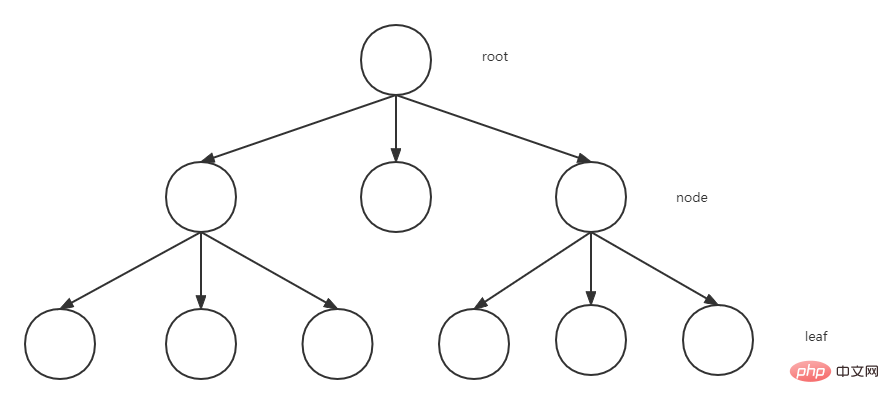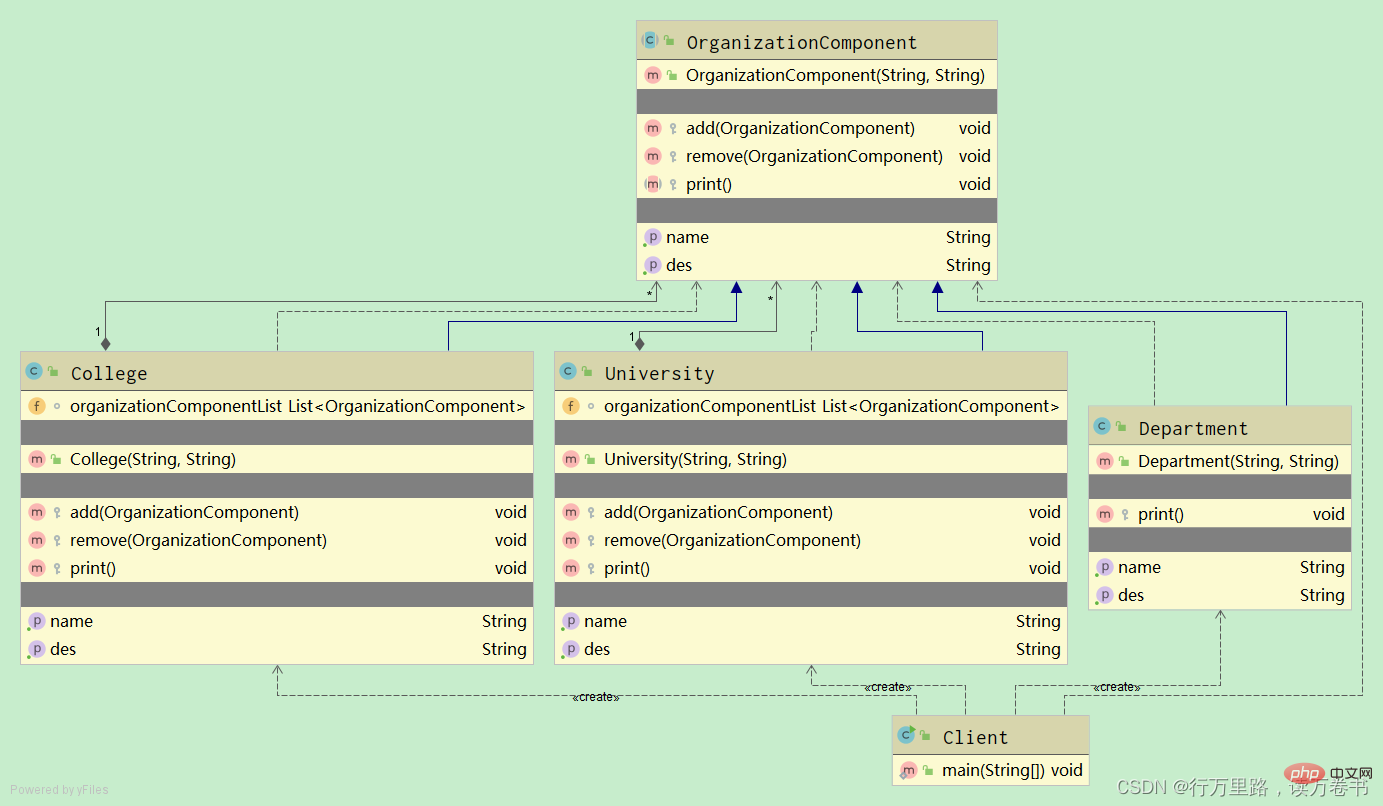Java design pattern composition pattern example analysis
1.Basic introduction
1) Composite Pattern, also called Partial Whole Pattern, creates a tree structure of object groups and combines objects into a tree structure to represent "whole- The hierarchical relationship of "part"
2) The combination mode combines objects according to the tree structure to represent the part and the whole hierarchy
3) This type of design pattern belongs to the structural pattern
4) The combination mode enables users to have consistent access to single objects and combined objects, that is: combination allows customers to process individual objects and combined objects in a consistent manner
2. Structure
The combination mode mainly includes three roles:
Abstract root node (Component): defines the common methods and attributes of objects at all levels of the system, and can predefine some default behaviors and attributes
Branch node (Composite): Define the behavior of branch nodes, store child nodes, and combine branch nodes and leaf nodes to form a tree structure
Leaf node (Leaf): Leaf node object, with no branches below it, is the smallest unit for system level traversal
3. Problems solved by the combination mode
1) The combination pattern solves this problem. When the object we want to process can generate a tree structure, and we want to operate on the nodes and leaves on the tree, it can provide a consistent way, regardless of whether it is a node or a leaf.
2) Corresponding schematic diagram

#4. Combination model to solve school department display
1) Application example requirements
Write a program to display the departmental structure of a school: the demand is as follows. To display the school’s departmental composition on one page, a school has multiple colleges, and a college has multiple departments
2) Idea analysis and illustration (class diagram)

package com.zte;
public abstract class OrganizationComponent {
private String name;// 名字
private String des;// 说明
public String getName() {
return name;
}
public String getDes() {
return des;
}
protected void add(OrganizationComponent organizationComponent) {
// 默认实现
throw new UnsupportedOperationException();
}
protected void remove(OrganizationComponent organizationComponent) {
// 默认实现
throw new UnsupportedOperationException();
}
// 构造器
public OrganizationComponent(String name, String des) {
this.name = name;
this.des = des;
}
// 方法print,抽象方法
protected abstract void print();
}package com.zte;
import java.util.ArrayList;
import java.util.List;
// University 就是 Composite,可以管理College
public class University extends OrganizationComponent {
List<OrganizationComponent> organizationComponentList = new ArrayList<>();
// 构造器
public University(String name, String des) {
super(name, des);
}
//重写add
@Override
protected void add(OrganizationComponent organizationComponent) {
organizationComponentList.add(organizationComponent);
}
// 重写remove
@Override
protected void remove(OrganizationComponent organizationComponent) {
organizationComponent.remove(organizationComponent);
}
@Override
protected void print() {
System.out.println("==========" + getName() + "=========");
for (OrganizationComponent organizationComponent : organizationComponentList) {
organizationComponent.print();
}
}
@Override
public String getName() {
return super.getName();
}
@Override
public String getDes() {
return super.getDes();
}
}package com.zte;
import java.util.ArrayList;
import java.util.List;
public class College extends OrganizationComponent {
// list中存放department
List<OrganizationComponent> organizationComponentList = new ArrayList<>();
public College(String name, String des) {
super(name, des);
}
//重写add
@Override
protected void add(OrganizationComponent organizationComponent) {
organizationComponentList.add(organizationComponent);
}
// 重写remove
@Override
protected void remove(OrganizationComponent organizationComponent) {
organizationComponent.remove(organizationComponent);
}
@Override
protected void print() {
System.out.println("==========" + getName() + "=========");
for (OrganizationComponent organizationComponent : organizationComponentList) {
organizationComponent.print();
}
}
@Override
public String getName() {
return super.getName();
}
@Override
public String getDes() {
return super.getDes();
}
}package com.zte;
public class Department extends OrganizationComponent {
public Department(String name, String des) {
super(name, des);
}
// add和remove方法就不需要再写了
@Override
protected void print() {
System.out.println("===========" + getName() + "=========");
}
@Override
public String getName() {
return super.getName();
}
@Override
public String getDes() {
return super.getDes();
}
}package com.zte;
public class Client {
public static void main(String[] args) {
// 创建大学
OrganizationComponent university = new University("清华大学", "中国最好的大学");
// 创建学院
OrganizationComponent college1 = new College("计算机学院", "计算机学院");
OrganizationComponent college2 = new College("信息工程学院", "信息工程学院");
// 创建各个学院下面的系
college1.add(new Department("软件工程", "软件工程"));
college1.add(new Department("网络工程", "网络工程"));
college1.add(new Department("计算机科学与技术", "老牌专业"));
college2.add(new Department("通信工程", "通信工程"));
college2.add(new Department("信息工程", "信息工程"));
// 将学院添加到学校中
university.add(college1);
university.add(college2);
// 打印大学底下的所有院系
university.print();
// 打印学院底下的所有系
college1.print();
}
}4) When you need to traverse the organization structure, or the object being processed has a tree structure, it is very suitable to use the combination mode 5) Requires high abstraction, if there are many differences between nodes and leaves, For example, many methods and properties are different, so it is not suitable to use the combination mode
The above is the detailed content of Java design pattern composition pattern example analysis. For more information, please follow other related articles on the PHP Chinese website!

Hot AI Tools

Undresser.AI Undress
AI-powered app for creating realistic nude photos

AI Clothes Remover
Online AI tool for removing clothes from photos.

Undress AI Tool
Undress images for free

Clothoff.io
AI clothes remover

Video Face Swap
Swap faces in any video effortlessly with our completely free AI face swap tool!

Hot Article

Hot Tools

Notepad++7.3.1
Easy-to-use and free code editor

SublimeText3 Chinese version
Chinese version, very easy to use

Zend Studio 13.0.1
Powerful PHP integrated development environment

Dreamweaver CS6
Visual web development tools

SublimeText3 Mac version
God-level code editing software (SublimeText3)

Hot Topics
 Smith Number in Java
Aug 30, 2024 pm 04:28 PM
Smith Number in Java
Aug 30, 2024 pm 04:28 PM
Guide to Smith Number in Java. Here we discuss the Definition, How to check smith number in Java? example with code implementation.
 Java Spring Interview Questions
Aug 30, 2024 pm 04:29 PM
Java Spring Interview Questions
Aug 30, 2024 pm 04:29 PM
In this article, we have kept the most asked Java Spring Interview Questions with their detailed answers. So that you can crack the interview.
 Break or return from Java 8 stream forEach?
Feb 07, 2025 pm 12:09 PM
Break or return from Java 8 stream forEach?
Feb 07, 2025 pm 12:09 PM
Java 8 introduces the Stream API, providing a powerful and expressive way to process data collections. However, a common question when using Stream is: How to break or return from a forEach operation? Traditional loops allow for early interruption or return, but Stream's forEach method does not directly support this method. This article will explain the reasons and explore alternative methods for implementing premature termination in Stream processing systems. Further reading: Java Stream API improvements Understand Stream forEach The forEach method is a terminal operation that performs one operation on each element in the Stream. Its design intention is
 TimeStamp to Date in Java
Aug 30, 2024 pm 04:28 PM
TimeStamp to Date in Java
Aug 30, 2024 pm 04:28 PM
Guide to TimeStamp to Date in Java. Here we also discuss the introduction and how to convert timestamp to date in java along with examples.
 Java Program to Find the Volume of Capsule
Feb 07, 2025 am 11:37 AM
Java Program to Find the Volume of Capsule
Feb 07, 2025 am 11:37 AM
Capsules are three-dimensional geometric figures, composed of a cylinder and a hemisphere at both ends. The volume of the capsule can be calculated by adding the volume of the cylinder and the volume of the hemisphere at both ends. This tutorial will discuss how to calculate the volume of a given capsule in Java using different methods. Capsule volume formula The formula for capsule volume is as follows: Capsule volume = Cylindrical volume Volume Two hemisphere volume in, r: The radius of the hemisphere. h: The height of the cylinder (excluding the hemisphere). Example 1 enter Radius = 5 units Height = 10 units Output Volume = 1570.8 cubic units explain Calculate volume using formula: Volume = π × r2 × h (4
 PHP vs. Python: Understanding the Differences
Apr 11, 2025 am 12:15 AM
PHP vs. Python: Understanding the Differences
Apr 11, 2025 am 12:15 AM
PHP and Python each have their own advantages, and the choice should be based on project requirements. 1.PHP is suitable for web development, with simple syntax and high execution efficiency. 2. Python is suitable for data science and machine learning, with concise syntax and rich libraries.
 PHP: A Key Language for Web Development
Apr 13, 2025 am 12:08 AM
PHP: A Key Language for Web Development
Apr 13, 2025 am 12:08 AM
PHP is a scripting language widely used on the server side, especially suitable for web development. 1.PHP can embed HTML, process HTTP requests and responses, and supports a variety of databases. 2.PHP is used to generate dynamic web content, process form data, access databases, etc., with strong community support and open source resources. 3. PHP is an interpreted language, and the execution process includes lexical analysis, grammatical analysis, compilation and execution. 4.PHP can be combined with MySQL for advanced applications such as user registration systems. 5. When debugging PHP, you can use functions such as error_reporting() and var_dump(). 6. Optimize PHP code to use caching mechanisms, optimize database queries and use built-in functions. 7
 Create the Future: Java Programming for Absolute Beginners
Oct 13, 2024 pm 01:32 PM
Create the Future: Java Programming for Absolute Beginners
Oct 13, 2024 pm 01:32 PM
Java is a popular programming language that can be learned by both beginners and experienced developers. This tutorial starts with basic concepts and progresses through advanced topics. After installing the Java Development Kit, you can practice programming by creating a simple "Hello, World!" program. After you understand the code, use the command prompt to compile and run the program, and "Hello, World!" will be output on the console. Learning Java starts your programming journey, and as your mastery deepens, you can create more complex applications.






